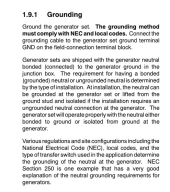With an entirely off grid system. The inverter "ground" refers back to the inverter case, not the earth. It is the same with the generator, the "ground" refers back to the lug on the generator frame. All your outlets and other device ground wires must return to the inverter and generator frame. If a generator is used to supply more than one fixed location it then needs a earth ground rod. Having your off grid system "grounded" to the earth will not hurt, but not help. Some Building Codes require many things that make little sense, but must be followed to please inspectors.
The solar panel frames must be connected to the earth "ground". This is to bleed static to help avoid lightning strikes. It also helps reduce damage from lightning. In Theory.
The solar panel frames must be connected to the earth "ground". This is to bleed static to help avoid lightning strikes. It also helps reduce damage from lightning. In Theory.



